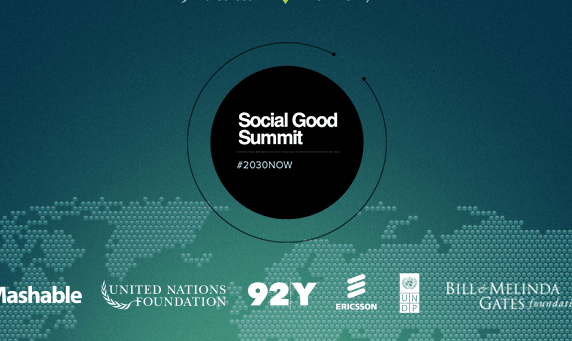Social Good Summit, New York – A thought-provoking discussion on violence against women and children took place this afternoon at the Social Good Summit. Bringing together Anthony Lake, Executive Director of UNICEF, former child soldier and activist Ishmael Beah , journalist and co-founder of Man Up Jimmie Briggs, and Rebecca Chiao, the co-founder and Director, HarassMap, the dialogue focused on how to make the invisible visible.
Unleashing The Transformative Power of Digital Tools
Rebecca Chiao noted that, according to a recent UN study in Egypt, a staggering 99.3% of women interviewed said they had experienced sexual assault. As the crowd at Social Good Summit let that number sink in, Chiao immediately followed up with the better news – there is now over 100% mobile penetration rate in Egypt, meaning that every cell phone owned or accessible to a woman can become a tool for reporting on, and ending gender-based violence. Her organization, HarassMap, has created an online and mobile phone-based reporting system “to give people a voice” – especially women from more traditional or isolated areas. This system is used to break the silence and mobilize bystanders to intervene when they see it happen. Indeed, HarassMap has 700 volunteers all over Egypt who go into communities, and take the information they gather to “create an environment that does not tolerate sexual harassment anymore,” Chiao explained.
The UN #EndViolence campaign also relies on the widespread availability of digital media and people’s engagement with online and mobile platforms. With a powerful PSA narrated by Liam Neeson, and an online campaign that seeks to educate and mobilize people across the world in order to change the cultural norms that allow violence against children and women to remain invisible issues.
For his part, Jimmie Briggs spoke about how technology “creates a way for us to tell people this is a global issue not limited to one person or one country, and it demands a universal response.” It also is a powerful avenue for telling stories, which is one way of decreasing stigma for survivors of gender-based violence. Briggs noted that it’s key to engage young men and boys in conversation about violence early in life, and to do so through the channels they connect with. Whether through gaming, sports or music, efforts and initiatives to end violence against women and children should use “whatever venue allows them to have a candid dialogue, and share ideas and experiences.”
Chiao put it simply, saying we can leverage technology to end violence against women, because it’s an “open channel of communication that does not require a lot of resources.” Already, HarassMap is being replicated in 25 countries; 9 have already launched.
Broadening Definitions
One of the themes that emerged from the conversation is that it’s important to look at violence against women and children in a holistic manner. Of course, the issue of women and children being beaten or brutalized is at the heart of the issue, but the speakers illustrated how much broader this definition needs to be. The #EndViolence campaign, for example, broadens the definition to include prostitution, trafficking and even emotional forms of violence like bullying. Ishmael Beah eloquently spoke about how while many people “get” the issue of child soldiers, they sometimes don’t fully appreciate the violence perpetrated against children in that context. In many parts of the world where child soldiering is a problem, babies are born without birth certificates or any formal paperwork. If they get caught up in conflict, their age is often assessed as higher than it actually is, and they are made to behave violently as though they had the free will of an adult. And, later, they are punished as adults – even though they are children. In Beah’s view, this constitutes a profound form of violence that must be addressed.
Personal, Local, National and International Engagement
Ending violence against women and children requires the engagement and participation of people at all levels. On a personal level, individuals can engage via platforms such as the UNICEF #EndViolence campaign, but also through the use of reporting tools, and using their voice, speaking up and standing up against violence. It is equally important to engage peers and communities and dialogue, to change the cultural norms and the paradigm around the acceptance of violence against weaker members of society. On the national level, Anthony Lake argues that it is essential for governments “to put teeth into laws and policies that can fight [violence against women and children].” Internationally, we can mobilize online and act together, and get momentum behind the effort.
Channeling Anger for Good
“I’m fueled by flat out anger,” said Anthony Lake, “but emotion isn’t enough. If you have outrage without action, you’re simply posturing.” Across the world, people have been shocked and angered by the story of Malala, the rapes in India and South Africa – these feelings can be channeled into building a positive movement.
The speakers in this session spoke of the importance of building awareness, understanding and educating people – and especially young men – to the moral and ethical issues that surround violence against women and children. We must have these discussions – as mentioned above, at all levels of society – to ensure that the next generation of men have a different attitude towards violence. “If we don’t end this,” said Beah, “the next generation will not know how to be ethical in the world because they will have never experienced it.”
